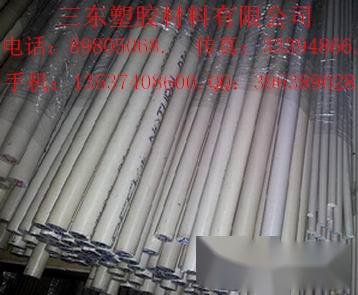 PEEK Rod - Performance Overview:
PEEK rods are extruded from UK Victrex PEEK raw material. PEEK rods not only have better heat resistance than other high-temperature plastics, but also possess high strength, high modulus, high fracture toughness, and excellent dimensional stability. The toughness of PEEK rods and their outstanding fatigue resistance to alternating stress make them comparable to alloy materials among all plastics.
PEEK Rod - Performance Overview:
PEEK rods are extruded from UK Victrex PEEK raw material. PEEK rods not only have better heat resistance than other high-temperature plastics, but also possess high strength, high modulus, high fracture toughness, and excellent dimensional stability. The toughness of PEEK rods and their outstanding fatigue resistance to alternating stress make them comparable to alloy materials among all plastics.PEEK rods are a high-performance thermoplastic specialty engineering plastic with excellent mechanical properties, chemical resistance, wear resistance, and hydrolysis resistance. They are lightweight and have good self-lubricating properties. Due to their excellent processing performance, they can be filled with carbon fiber, molybdenum disulfide, and other materials for wear rings.
The outstanding performance of PEEK rod materials is mainly reflected in the following aspects:
High-temperature resistance
PEEK has a high glass transition temperature and melting point (334℃), which is one reason why it can be reliably used in applications requiring heat resistance. Its load thermal deformation temperature can reach up to 316℃, with a continuous use temperature of 260℃.
Mechanical properties:
PEEK is a plastic that balances toughness and rigidity. In particular, its excellent fatigue resistance to alternating stress is outstanding among all plastics and comparable to alloy materials.
Self-lubricating property:
PEEK has outstanding sliding characteristics among all plastics, making it suitable for applications that require low friction coefficients and wear resistance. Especially, PEEK modified with a certain proportion of carbon fiber and graphite shows even better self-lubricating properties.
Chemical resistance (corrosion resistance):
PEEK has excellent chemical resistance. Among common chemicals, only concentrated solutions can dissolve or damage it, and its corrosion resistance is comparable to that of nickel steel.
Flame retardancy:
PEEK is a very stable polymer. A sample of 1.45mm thickness can meet high flame retardancy standards without the addition of any flame retardants.
Peel strength:
PEEK has good peel strength, making it suitable for manufacturing thinly coated wires or electromagnetic wires that can be used under harsh conditions.
Fatigue resistance:
PEEK exhibits good fatigue resistance among all resins.
Radiation resistance:
PEEK has strong radiation resistance, exceeding that of polyethylene, which is known for its radiation resistance among general resins. It can be made into high-performance wires that maintain good insulation capabilities even after γ-ray doses of up to 1100 Mrad.
Hydrolysis resistance:
PEEK and its composites are not chemically affected by water or high-pressure steam, and products made from this material can maintain excellent properties even when used continuously in high-temperature and high-pressure water.
Applications of PEEK rods:
PEEK-1000 (brown-gray) is made from pure polyether ether ketone resin and exhibits good toughness and impact resistance among all PEEK grades. PEEK-1000 can be conveniently sterilized using various methods (steam, dry heat, and Y-rays), and the raw material components used to manufacture PEEK-1000 comply with EU and US FDA regulations regarding food safety, making it widely used in the medical, pharmaceutical, and food processing industries.
PEEK-HPV (black) incorporates PTFE, graphite, and carbon fiber, making PEEK-HPV a bearing-grade plastic. Its superior friction performance (low friction coefficient, wear resistance, and high peak pressure limit) makes it an ideal material for friction applications. PEEK-GF30 (brown-gray) is a glass fiber-reinforced grade containing 30% glass fiber, offering better rigidity and creep resistance, as well as better dimensional stability compared to PEEK-1000, making it ideal for manufacturing structural parts. It can withstand fixed loads for extended periods at high temperatures. If PEEK-GF30 is used as a sliding component, careful examination of its adaptability is necessary, as glass fibers may scratch mating surfaces.
PEEK-CA30 (black) is filled with 30% carbon fiber reinforcement, providing better mechanical properties (higher elastic modulus, mechanical strength, and creep resistance) and wear resistance compared to PEEK-GF30. Moreover, carbon fiber-reinforced plastics have 3.5 times the thermal conductivity of unreinforced PEEK plastics, allowing for quicker heat dissipation from bearing surfaces.
Specifications of PEEK rods: 2-200MM*1000MM
Main production areas of PEEK rods: Germany, the USA, Japan, and others.
Friendly reminder:
Above 150 ℃ (higher than the glass transition temperature), the mechanical properties of all PEEK grades rapidly decline, while the linear thermal expansion coefficient increases significantly. For operations at temperatures exceeding 150 ℃, PAL materials can be selected to manufacture high-temperature components.













